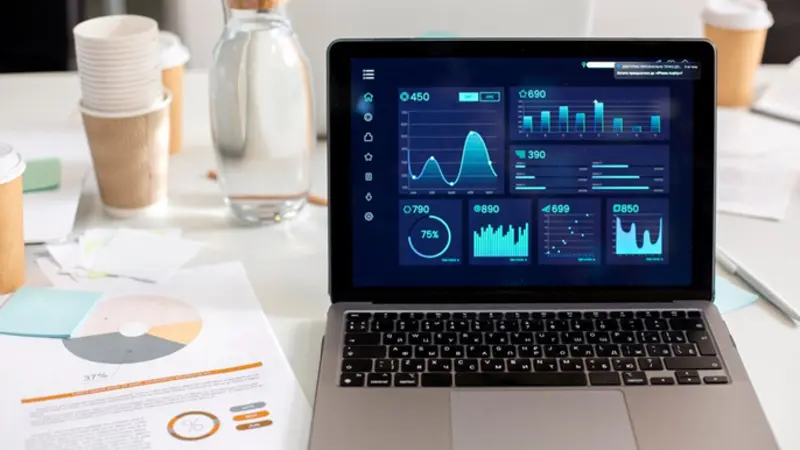Among data experts, AI data analysis is becoming more popular. This post teaches you five different methods to use AI to your advantage for data analytics.
Artificial intelligence is rapidly gaining traction in a variety of applications. However, what is the real benefit of using data analytics?
This essay will examine five distinct applications of AI in data analytics. You may swiftly and simply use each of these techniques because they all use various instruments that are often used in the industry.
Discover what these novel approaches are by reading on!
What is AI in Data Analytics?
Large-scale data analysis using artificial intelligence (AI) is the fundamental function of AI in data analytics. This makes it possible for scientists and data analysts to find patterns and learn more about how customers or other datasets behave. AI may assist in rapidly and accurately making sense of vast amounts of data using strong machine-learning algorithms.
The Importance of AI in Data Analytics
Let’s look at some advantages of AI in data analytics to help you better grasp why it’s necessary to use it.
1. Speed and Effectiveness
Because AI systems digest data far more quickly than humans, your analyses will yield more accurate and timely insights. Organizations find it simpler to make decisions and take swift action as a result.
Additionally, humans are not able to properly recall all of the commands or library syntaxes used by the various data analysis libraries. You may easily seek up these commands with the aid of an AI assistant, which can also offer different angles for your analysis.
2. Verifying Found Evidence
You can find data inconsistencies fast with AI techniques.
For example, an AI chatbot can assist in determining the reason(s) if the analytics results do not match your expectations. Some AI models can even identify mistakes or possible problems before they arise.
3. Democratization of Data
AI can also enable more equitable access to data. A different article will teach you more about data democratization.
Through the use of natural language processing (NLP) in AI chatbots, companies may enable regular non-data users to swiftly extract important insights from big data sets and analyze them.
Because of this, less skilled users can now more easily access complicated datasets without needing to use the specialized jargon used in data research.
4. Automatic Creation of Reports
Businesses can use AI to automate the report generation process. AI solutions can swiftly and automatically generate reports, saving time and effort when preparing reports for each specific analysis.
These automated reports guarantee that irrespective of their location or background, every employee has timely access to the same information.

5 Unique Ways to Use AI in Data Analytics
We examine whether AI will eventually replace programming in a different topic. In it, we conclude that AI will most likely replace individuals employed in programming and data analytics. Some companies want to have AI and data analytics services as they very essential to their business.
The following are a few applications of AI in data analysis:
1. Generating code & debugging errors
Let’s talk about using AI to make coding easier, especially when you’re generating code or fixing mistakes in data analysis. This is super useful for tricky tasks, like handling big sets of data or making machine-learning models.
There are some handy AI tools you can use, as well as tools that can also help you finish your code. You can start typing a function, and the AI will fill in the rest based on what you’ve written.
They’re also great for finding and fixing errors in your code, which saves you a ton of time hunting for solutions.
Even if you’re an Excel user, these AI tools can help you create formulas and macros to make your work easier.
2. Insightful Thoughts and Analysis
In data analytics, elucidating findings and delving further into the data are occasionally required to derive genuine commercial insight. AI can be useful in this situation.
You can quickly explain why a certain data point on a chart is acting a certain way and offer further insights into it by using AI tools for data analysis like Tableau GPT.
For instance, you may pose direct queries like these:
- “Why did the sales decrease in March?”
- “What could be the cause of the spike in users?”
- “Which is our best revenue quarter for the year?”
After that, the AI chatbot will go over your datasets, looking for patterns and correlations that can help you find the answers to your queries.
In your data analytics project, you might also utilize this function for additional purposes, such as exploratory data analysis if you come across a new dataset or database.
3. Making Artificial Information
The creation of synthetic data is a helpful use of AI in the analytics space. Data scientists and machine learning engineers may find this very helpful.
One way to produce and feed training datasets into machine-learning models is as follows. Either free tools like ChatGPT or other premium tools can be used for this.
This facilitates the process of experimenting with various models and evaluating their performance using the produced data. This is particularly helpful if you require training datasets that are more difficult to come by, such as different types of media, such as pictures and videos.
Automated data imputation is another way artificial intelligence (AI) can support data analysis. More rapidly and precisely, datasets with missing values or outliers can be filled in with the aid of automated imputation.
4. Building Reports and Dashboards
Afterward, interactive dashboards and reports can be made using AI.
For instance, you may quickly compile data from several sources into an easy-to-read dashboard or report by using an AI-driven tool like Tableau GPT.
Even prior experience in the field of data visualization is not required. All you have to do is choose the data you want to have visualized, and the AI will take care of the formatting, creating an easy-to-read chart or graph.
Additionally, utilizing the Midjourney AI to produce some visually striking dashboard concepts related to your analysis is another inventive way to employ AI to help with the creation of stunning charts. See our help on using Midjourney for additional information.
Dashboards can then be created using these concepts as inspiration.
5. Automated Image-Based Data Entry
Lastly, AI may be utilized to automate the process of data entry from photos, which is beneficial for all data analysts who regularly work with Excel or other spreadsheets.
This lets you enter the required information quickly and eliminates the need for manual data entry, which is especially helpful when gathering huge amounts of data from photos or documents.
Excel’s “insert data from the picture” feature is one tool that can be useful for this task. It can save you a great deal of time and work by converting photos of tabular data into digital datasets via computer vision on the backend.
This function is very helpful for companies in the medical field that handle a lot of images, including MRIs and X-rays. AI can assist these companies in accurately and swiftly extracting and entering vital data from these photos.
Future Directions for Analytics and AI
Data analytics and artificial intelligence are closely related fields, and their futures most likely involve more integration. Artificial Intelligence (AI) will play a bigger role in data analysis going forward, helping to produce insights from massive datasets and identify patterns in data.
We anticipate additional advancements in automated report generation and increased application of natural language processing (NLP) to facilitate natural language prompting, hence improving the accessibility and comprehensibility of data.
Furthermore, as businesses keep an increasing amount of personal data, artificial intelligence will play a growing role in data security. Artificial intelligence (AI) systems can spot trends or unusual behavior that might point to malicious activities, assisting in the defence of user data from online thieves.
Final Thoughts
To summarize, the increasing prevalence of AI in data analytics can be attributed to its advantages in terms of speed, automation, democratization, and data validation.
Given the rapid development of new tools and applications, the use of AI in data analytics appears to have a bright future. Creating synthetic data, constructing dashboards, elucidating findings, automating data entry, and coding for data analysis are a few of these.
Applying these methods and resources can help you stay up-to-date as a data professional and improve the quality of your work. You will be able to handle data analysis jobs more accurately and effectively if AI is on your side.
